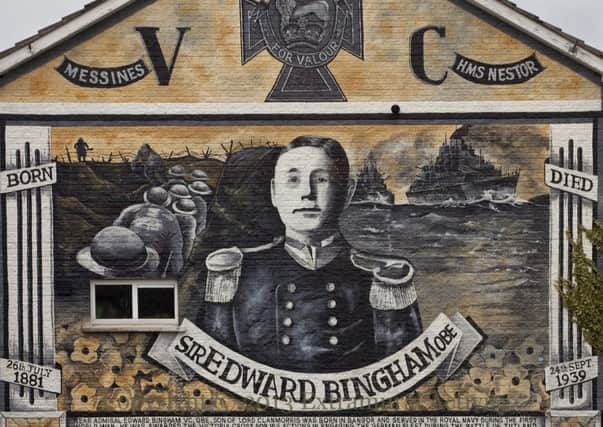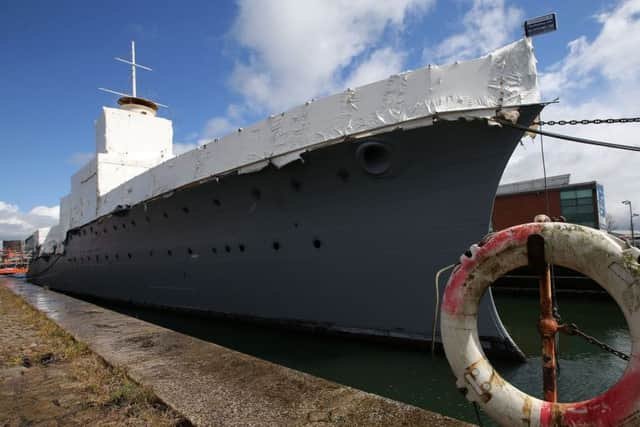Battle of Jutland: Still generating controversy, 100 years on


This year marks not only the centenary of the Battle of the Somme but the Battle of Jutland.
The Somme, undoubtedly, exerts a much greater influence on the popular imagination but the importance of the Battle of Jutland should not be discounted.
Advertisement
Hide AdAdvertisement
Hide AdOne hundred and fifty ships of the British Grand Fleet, commanded by Admiral Jellicoe, confronted 100 ships of the German High Seas Fleet, commanded by Admiral Scheer, in the grey waters of the North Sea on May 31-June 1 1916, making it the largest naval engagement of the Great War. As aircraft played no part in the battle and submarines played only a minimal role (although fear of them figured prominently in Admiral Jellicoe’s calculations), Jutland remains the biggest and last purely surface encounter in naval history.


However, even after a century the battle continues to generate controversy.
There is no consensus as to what the battle should be called or, even more astonishingly, its outcome.
The Germans call it the Battle of the Skagerrak, after an arm of the North Sea, about 60 miles off the coast of the Jutland peninsula, and insist it was a German victory. The Tageszeitung hailed it as ‘victory over the mightiest fleet in the world’.
Advertisement
Hide AdAdvertisement
Hide AdThe British chose to name the battle after the Danish peninsula and insisted, with some justice, that it was a British victory.


There are two obvious local connections with the Battle of Jutland. First, HMS Caroline, the last surviving ship from the Battle of Jutland, is based in Alexandra Dock, Belfast.
HMS Caroline, a C-class cruiser, was built by Cammell Laird of Birkenhead, was laid down on January 28 1914, launched on September 29 1914 and was commissioned on December 4 of that year.
Caroline retains the record of having the fastest build time of any significant warship – eight months from her keel being laid until her launch.
Advertisement
Hide AdAdvertisement
Hide AdFor the greater part of the war she served with the 4th Light Cruiser Squadron. The ship and her crew make fleeting appearances in Jutland 1916, the excellent account of the battle by Nigel Hart and Peter Hart.
Two members of the crew were killed during the battle. Between 1924 until her decommissioning in 2011, HMS Caroline served as the headquarters of the Ulster Division of the Royal Naval Reserve and its training facility.
Secondly, the Ulster personnel who fought and died in the battle is another local connection. This sample of those killed at Jutland, indicates that Ulstermen of different social classes were serving in the Royal Navy in a wide range of different capacities:
• Engineer Sub-Lieutenant W. H. Unsworth was killed in action aboard HMS Invincible, a battlecruiser. His parents lived at Kirkliston Drive, Bloomfield.
Advertisement
Hide AdAdvertisement
Hide Ad• Sub-Lieutenant P. J. Vance was killed on HMS Shark, a destroyer. His father was the manager of the central branch of the Belfast Bank. Vance was born in Co Fermanagh but his parents lived in Helen’s Bay.
• Surgeon-Probationer D. H. Ferris was the only son of David Ferris of Rostrevor, head of Messrs Henry Thomson & amp; Co, Newry. He was aboard HMS Broke.
• Carpenter Thomas Walls, DSC, serving on HMS Invincible, was the son of Thomas Walls, Townparks, Strabane.
• Richard Joseph McBrinn was an engine room artificer aboard HMS Barham, a battleship. His mother resided at 2 Roseleigh Street.
Advertisement
Hide AdAdvertisement
Hide Ad• Lieutenant A.D.P. Hamilton, the Royal Marine Light Infantry, serving aboard the armoured cruiser HMS Defence, was the only son of W.A. Hamilton, Coxtown, Co Donegal.
• Two Belfast brothers, Chief Engineroom Artificer Charles Taylor and Cooper William Taylor, were also killed serving on HMS Defence. Their mother lived at 23 Melrose Street, Belfast.
One of the first ‘deaths’ to be reported by the Belfast News Letter was that of Commander the Hon. E. B. S. Bingham, third son of Lord and Lady Clanmorris of Bangor Castle, who was the commander of HMS Nestor, a destroyer. However, the report proved inaccurate because the Commander had been picked up by a German destroyer after the sinking of the Nestor.
Nor, understandably, was the Belfast News Letter at that stage aware of the personal courage and the quality of the leadership which Bingham had displayed at Jutland.
Advertisement
Hide AdAdvertisement
Hide AdOn sighting the enemy, the Bangor-born Bingham had ordered his own destroyer and HMS Nicator, to close to within 2,750 metres of the German battle fleet so that he could deploy his torpedoes. While mounting their attack Nestor and Nicator came under concerted fire and Nestor was subsequently sunk. For his leadership and courage Bingham earned the Victoria Cross, one of the comparatively few awarded for naval bravery during the Great War.
As has already been noted, both sides claimed a victory. Kaiser Wilhelm promptly claimed victory on behalf of the High Seas Fleet because the Germans had destroyed and crippled many more ships and men.
The Admiralty belatedly claimed victory for the Royal Navy because it retained control of the North Sea.
The Royal Navy lost 6,094 sailors whereas the Germans lost 2,551 sailors. Of the 110,000 sailors engaged in the battle, less than eight per cent lost their lives. Statistically, a sailor had a better chance of surviving Jutland than a soldier had of surviving the carnage on July 1 at the Somme.
Advertisement
Hide AdAdvertisement
Hide AdIn terms of ships, the Royal Navy lost 14: three battle cruisers, three cruisers, eight destroyers. The Germans lost 11: one battleship, one battle cruiser, four light cruisers and five destroyers.
In terms of tonnage, the Royal Navy lost 110,000 tons compared to 62,000 lost by the German navy.
Initially, the British public was extremely disappointed with the outcome of the battle. Public opinion expected nothing short of a new Trafalgar. Jellicoe was to be a second Nelson. The Royal Navy’s failure to live up to these grandiose expectations blinded many people to the reality that Jutland was a British strategic victory.
However, Jutland did highlight that German gunnery was more accurate than British gunnery and that German shells were more effective than British ones. British gunners sacrificed accuracy to rapidity of gunfire and ran unacceptable risks to achieve that rapidity. British ships were less well armoured and possessed fewer water-tight bulkheads than German ones.
Advertisement
Hide AdAdvertisement
Hide AdThe losses inflicted on the Grand Fleet did not even dent its superiority over the High Seas Fleet. Only eight British compared with 10 German capital ships were damaged.
Jellicoe had 24 Dreadnoughts and battle cruisers unscathed and ready for action on June 1 whereas Scheer had only 10. Britannia continued to rule the waves.
Henceforth, the High Seas Fleet rarely chose to venture out from the safety of its home ports. As a German commentator has conceded, Jutland was akin to an assault on the gaoler followed by a return to goal.
In October 1916 the Germans resumed unrestricted submarine warfare. As the war drew to a close the High Seas Fleet mutinied rather than fight another battle with the Grand Fleet.
Advertisement
Hide AdAdvertisement
Hide AdThe ultimate triumph of the Royal Navy came on November 21 1918 when the 70 ships of the High Seas Fleet surrendered to the Grand Fleet.
The Battle of Jutland in numbers
• 36: The length in hours the naval engagement lasted over May 31 and June 1 off the coast of Denmark’s Jutland peninsula.
• 6,094: The number of deaths on the British side.
• 2,551: The deaths on the German side.
• More than 1,000 others were injured.
• 249: The number of ships involved, with 150 British and 99 German vessels. The ships carried more than 100,000 sailors, making Jutland the largest naval battle in history.
• 25: The total number of warships sunk during the battle, 14 from the British Grand Fleet – including HMS Invincible and HMS indefatigable – and 11 from the German High Seas Fleet.
Advertisement
Hide AdAdvertisement
Hide Ad• 4: The number of Victoria Crosses awarded after the battle, to Major Francis Harvey, Commander Barry Bingham, Commander William Loftus Jones, and 15-year-old Boy First Class Jack Cornwell – who died from his injuries in the days after Jutland.